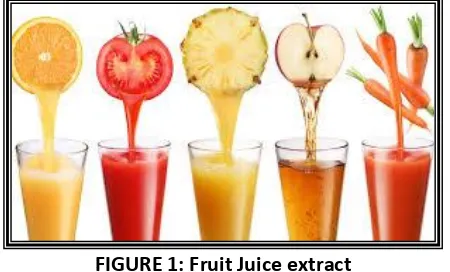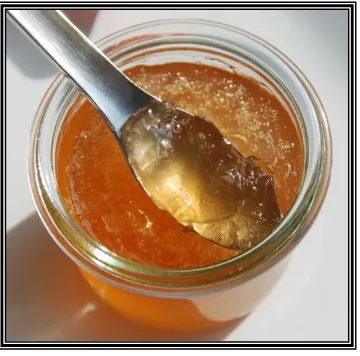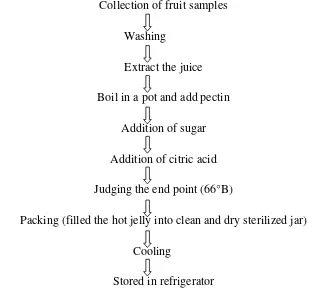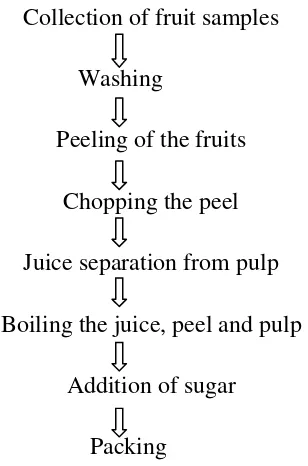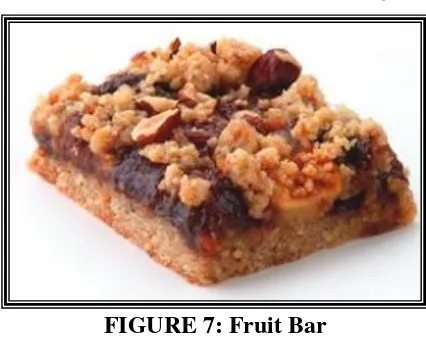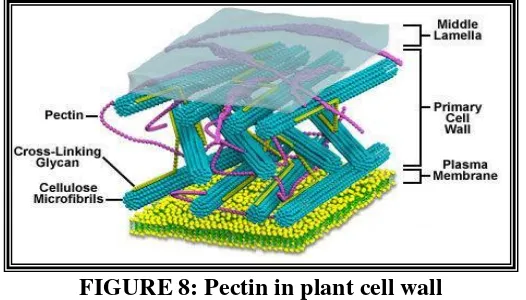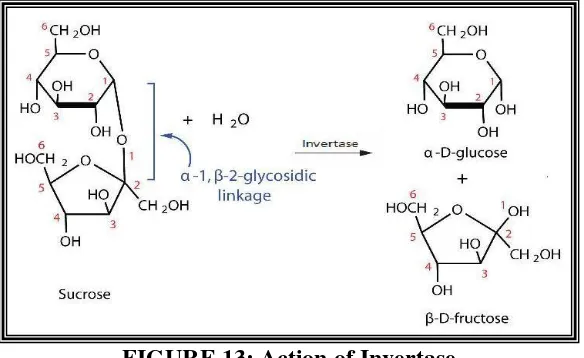International Journal of Universal Pharmacy and Bio Sciences 3(5): September-October 2014
PROCESSING OF FRUITS WITH SPECIAL REFERENCE TO
S. APETALA
FRUIT JELLY PREPARATION
Prosenjit Pramanick1*, Sufia Zaman2, Abhijit Mitra2
1
Department of Oceanography, Techno India University, Salt Lake Campus, Kolkata 700 091, India
2
Department of Marine Science, University of Calcutta, 35, B. C. Road, Kolkata 700 019, India; also attached to Techno India University, Salt Lake Campus, Kolkata 700 091, India.
KEYWORDS:
The scientific method of preparing jam, jelly, fruit bar and other fruit
products has opened a livelihood option in the modern era. These
fruit products are not only nutritionally rich, but they are also
economically viable to initiate a small scale industry. Preservation
and processing of fruit products are also important to maintain the
quality of the end products. The present paper is an approach to
develop various fruit products along with their preservation and
processing technology with special reference to jelly prepared from
Sonneratia apetala fruit, commonly available in Indian Sundarbans.
This jelly is rich in vitamin C and the source material (S. apetala
pulp) is abundantly found during the monsoon period. Proper storage
and marketing linkage may help to sustain small scale mangrove
INTRODUCTION:
Fruits are generally high in fibre, water, sugars, mineral, enzymes1 and their regular consumption in
sufficient amount could help in reduction of risk of cancer, cardiovascular diseases, stroke, Alzheimer
diseases, cataracts etc. They are also important sources of vitamin C, which is necessary in human diet
for activating the antibodies and combat diseases in the body2. A large amount of the carbohydrates
present in the fruits as fibre, usually made up of cellulose, hemicellulose, and pectic substances, is not
digested and passes through the digestive system. A small quantity of starch may also be present in
fruit, but it typically converted to sugars during the ripening process. Negligible quantities of protein
and fat are found in fruits. Fats are most typically associated with the waxy cuticle surface of the fruit
skin. Exceptions to this rule are avocados and olives, the flesh of which may contain as much as 20
percent oil.
Different food products like jam, jelly, fruit bar and marmalade are prepared from raw edible fruits.
Fruit jams, jellies and marmalades are made by cooking fruits (pieces, pulps and/or juice) with sugars,
gelling agents (usually pectin) and edible (usually organic) acids, and concentrating the mixture until a
characteristic and suitable consistency is obtained3. This is one of the oldest processes used by mankind
to preserve fruit for consumption in the off-season4. The minimum amount of fruits in the final product
may vary from about 35–45 wt % 3. Insoluble solids in the products may range from 0.9 to 10 wt % 5.
Modern manufacturing requirements for uniform gel strength and appearance preclude reliance on fruit
native pectin, which may vary in content and quality, depending on fruit maturity and variety.
Consequently, commercial pectin of known quality and gelling capacity is added to jam and jelly
formulations to achieve the desired gel strength 4. Considering the nutritional value of fruit products,
this paper attempts to highlight the preparation of Sonneratia apetala fruit jelly in livelihood domain of
Sundarbans. The Work has great relevance as the region is poverty stricken and is prone to sea level
rise, erosion, frequent natural calamities etc.
FRUIT PRODUCTS AND THEIR PREPARATION
Preparation and processing of fruit products is extremely important for maintaining the quality of
finished product. Some common methods of preparing juice, jam and jelly from fruits are discussed
here.
Fruit Juice
One of the most common fruit products is fruit juice (Fig. 1). Fruit juice is the liquid part of the fruit
that extracted by squeezing or crushed the fruit. The juice may be turbid or clear. It may have been
concentrated and later reconstituted with water suitable for the purpose of maintaining the essential
composition and quality factors of the juice. The addition of sugars or acids can be permitted but must
FIGURE 1:Fruit Juice extract
Fruit juice can be extracted as following procedure.
Collection of fruit samples
Washing
Either cut in half or select whole fruit
Extract the juice by squeezing
Packing
Fruit Jam
Jam is a type of fruit spread product (Fig. 2) made from whole, cut or crushed fruit boiled with sugar.
Almost any fresh fruit can be made into jam by mashing or slicing it fine, adding an approximately
equal amount of sugar, and simmering until it reaches the proper concentration or gel at 218° to 222°F;
(103°–105°C). It appears very rustic: a squishy, somewhat homogenous spread. It is frequently possible
to identify the original fruit just by looking at a jam. Jam tastes much like the original fresh fruit.
Jam is prepared as per the standard protocol7 and modified as follow:
Collection of fruit samples
Washing
Extract fruit pulp
Boil and add sugar
Addition of pectin and citric acid
Judging the end point (70°B)
Packing in a sterilized jar
Cool and stored in refrigerator
Fruit Jelly
Jelly is defined as the semisolid fruit product made from fruit juice8 (Fig. 3). It should be clear and free
from any residual parts of fruit and firm to hold its shape.
The standard procedure8 follows the jelly production at the industrial level and it is modified as follow: Collection of fruit samples
Washing
Extract the juice
Boil in a pot and add pectin
Addition of sugar
Addition of citric acid
Judging the end point (66°B)
Packing (filled the hot jelly into clean and dry sterilized jar)
Cooling
Stored in refrigerator
We prepared jelly from Sonneratia apetala fruit (Fig. 4), which is a mangrove tree found in Sundarbans
at lower Gangetic delta. The fruit is rich in Vitamin C9.
FIGURE 4:Sonneratia apetala fruit FIGURE 5:Sonneratia apetala jelly The jelly (Fig. 5) prepared from S. apetala fruit was found to be nutritionally high compared to orange
jelly and mango jelly9-11 (Table 1). This fruit available during monsoon season in lower Gangetic delta.
This region experiences extreme tidal surges, cyclonic depression and continuous erosion. The people
mostly are below poverty line and earned their livelihood depending on the forest products (like timber,
honey, wax, fishes etc.). These forest resources are obtained in illegal ways. It is expected that sizable
percentage of the population of this area may be attracted towards this jelly manufacturing technology
and upgrade their economic profile. However, proper institutional mechanism and capacity building are
Table 1:Comparison of nutrition values of fruit jellies with S. apetala fruit jelly
Marmalade is a fruit finished product made from the juice and peel of citrus fruits boiled with sugar and
water (Fig. 6). It can be produced from kumquats, lemons, limes, grapefruits, mandarins, sweet
oranges, bergamots and other citrus fruits, or any combination thereof. It looks like a jelly.
FIGURE 6:Fruit Marmalade
and minerals). Because of its complex nature, studies on jam’s structure are scarce and mostly
empirical.
Sugarless jam and jelly are made from fruit sweetened with an artificial sweetener along with a gelling
agent such as gelatin or pectin. These jams and jellies are made in small quantities, stored in the
refrigerator and must be used within 4 to 6 weeks.
Fruit Bar
Fruit bar is a type of cookies containing chopped fruits, either mix in the dough or spread between
layers of dough then baked and cut in bars. It has a chewy texture (Fig. 7).
FIGURE 7:Fruit Bar
Fruit bar can be prepared by maintaining the standard protocol12 and modifies as follow:
Collection of fruit samples
Washing
Weigh the pulp
Boiled and addition of sugar
Continued boiling with stirring
Addition of milk powder
Addition of hydrogenated fat
Addition of citric acid
Judging the end point (TSS 72 %)
Poured in tray and cooled at room temperature
Cut into equal pieces
INGREDIENTS OF JAM, JELLY PRODUCTS AND ITS SIGNIFICANCE
Pectin
Pectin is a white, amorphous, colloidal hetero-polysaccharide (carbohydrate) that is used as thickening
or gelling agent in the production of jam, jelly and other similar products. It naturally found in primary
cell wall of terrestrial plants and helps in the binding of cells together (Fig. 8). Pectin molecules are so
tightly liked to cell wall that they cannot be extracted by water and this water insoluble form is called
protopectin. Protopectin becomes soluble by acid hydrolysis and then extracted in hot water.
FIGURE 8:Pectin in plant cell wall
The amount of pectin in the fruit varies with the kind of fruit and degree of ripeness. The pectin content
of fruit is species specific in nature. S. apetala has rich pectin content. Under ripe fruit has higher
pectin content. As fruit ripens, the pectin is changed to a non gel-forming substance through broken
down it by the enzymes namely pectinase and pectinesterase and therefore the fruit becomes softer as
the middle lamellae break down and cells become separated from each other.
The molecular structure of pectin is composed of D-galacturonic acid molecules, which are linked to each other by α 1-4-glycosidic bond to formation of polygalacturonic acid (Fig. 9). Pectin molecules become heteropolysaccharide by neutral sugars like arabinose, galactose and xylose, which are linked
as side chains to the pectin macromolecules13-17. Around 80 % of the carboxyl groups of galacturonic
acid are esterifies with methanol and on this basis pectin is divides into two types. One is high
methoxyl pectin and another is low methoxyl pectin (Fig. 10).
FIGURE 10:High methoxyl pectin (left) and Low methoxyl pectin (right)
The gelling power of the pectin is based on its molecular weight i.e. the number of chains link a pectin
molecule boast. Pectin molecules contain negative charge that makes them to move away from each
other due to repulsion force. This negatively charged pectin molecule is changes to neutral molecule by
the addition of acid, allowing them to more close together and moving around freely for unbound
water. Addition of sugar helps in the binding of water molecules and form hydrogen bridges between
non-esterified carboxyl groups and this hydrophobic interaction binds the pectin molecules together
(Fig. 11). Methylester groups are the hydrophobic part of the pectin molecule. Hydrophobic forces push
them into aggregate formations, and form a gel matrix within pectin network. High methoxyl
pectin will only form gel if the amount of soluble solids is higher than 65% and the pH is 2.0 - 3.8.
FIGURE 11:Hydrophobic bridge of high methoxy pectin
Low-ester pectins need calcium to form a gel, but can do so at lower soluble solids and higher
pH-values than high-ester pectins. Normally low-ester pectins form gels with a range of pH from 2.6 to 7.0
and with soluble solids content between 10 and 70%.
Consumption of pectin has been shown to reduce blood cholesterol levels. The mechanism appears to
be an increase of viscosity in the intestinal tract, leading to a reduced absorption of cholesterol from
bile or food18. In the large intestine and colon, microorganisms degrade pectin and liberate short-chain
fatty acids that have positive influence on health.
Sugar
Sucrose is usually used in homemade jellied fruit products. From a practical point of view, it may be
advantageous to substitute other sugars for sucrose, either because of cost, or to reduce the likelihood of
crystallization, or for flavor modification19. Partial replacement of sucrose with other sugars such as
maltose, glucose, syrups, or high fructose corn syrup altered the setting times and certain rheological
properties of model gels20. Sweeteners such as brown sugar, sorghum, and molasses are not
recommended because their flavors overpower the fruit and their sweetness varies. Artificial sweeteners
than sugar and more healthful. However, when it is heated, it loses complexity of its fragrance, flavor
and perhaps also some of its health promoting properties. Besides, honey contains more water and so
may necessitate longer boiling. It also produces lot of foam during cooking and gelled preserves made
with honey tend to be soft. Therefore, honey cannot be used in making the fruit finished products.
The exact amount of sugar for the production is depends on the acidity level, the natural sugar content,
and the type of product desired. If sugar content is too low, the resulting jelly will be tough; excessive sugar, on the other hand, will create a “soft set” that can be broken easily.
Sugar plays some important roles in jam, jelly preparation by way be gelling, preserving, color
retardation etc. Each of these roles is discussed separately.
Gelling
Sugar is essential in the gelling process of jams and jellies to obtain the desired consistency and
firmness. Pectin, a natural component of fruits, has the ability to form gel only in the presence of sugar
and acid. Sugar attracts and holds water during the gelling process.
Preserving
Sugar prevents the spoilage of jams and jellies. Properly prepared and packaged products are free from
bacteria and yeast cells until the lid is opened and exposed to air. Once the jar is opened, sugar
incapacitates any microorganisms by its ability to attract water through osmosis (the process whereby
water will flow from a weaker solution to a more concentrated solution through semi-permeable
membrane). In that case, water is withdrawn from these microorganisms toward the concentrated sugar
syrup. The microorganisms become dehydrated and incapacitated, and are unable to multiply and bring
about food spoilage. In jellies and jams, a concentrated sugar solution of at least 65% is necessary to
perform this function. Since the sugar content naturally present in fruits in less than 65%, it is essential
to add sugar to raise it to this concentration for products preparation. Color Retention
Sugar helps to retain the color of the fruit products through its capacity to attract and hold water. Sugar
absorbs water more readily than other components in jam and jellies. Thus, sugar prevents the fruit
products from absorbing water which would cause its color to fade through dilution.
Acid
Citric acid is normally used in jam, jelly preparation. Acid acts as a flavouring agent in the jam, jelly
production. It also helps in the gel formation by lowering the pH. The pH must be adjusted of
approximately 3.1. Too much acid (pH < 2.5) will cause the gel to lose liquid and too little acid cannot
PRESERVATION OF FRUITS AND THEIR PRODUCTS
moisture in the fruit is driven off, leaving a stable food that has a moisture content below that at which
microorganisms can grow. There are three basic systems for dehydration: sun drying, such as that used
for raisins; hot-air dehydration; and freeze-drying.
Dehydration has a number of advantages. Dehydrated fruit has a virtually unlimited shelf life when
held under proper storage conditions. Drying does not significantly reduce the calories or minerals, and
vitamin losses are similar to other preservation methods. Dehydrated fruits are typically reduced in
weight by 75 to 90 percent.
Although dehydration offers a convenient product form, it usually requires a careful inactivation of
enzymes. This is usually accomplished by blanching of the fruit or by chemical inactivation. Typically,
sulfur dioxide is added for its antioxidant and preservative effects. In order to control browning, the
fruit is often treated prior to dehydration with sodium sulfite and sodium bisulfite.
Thermal processes
In thermal processing, heat is used to destroy spoilage organisms and to inactivate troublesome
enzymes. Enzymes are typically responsible for browning, softening, and the development of
off-flavours. Canning is the thermal process for high-acid fruit products, in which fruit or fruit products are
hot-filled or heated in a hermetically sealed container. The process temperature is generally 88° C (190°
F).
Chemical preservation
Chemicals also can be used as a preservative, either through artificial addition or through the action of
microorganisms. An example of the latter method is yeast fermentation, which can cause an increase in
ethyl alcohol sufficient to preserve the fruit product. Pickling is another example of chemical
preservation. In the case of pickling, the product may be preserved by the addition of salt, sugar, acetic
acid (vinegar), and alcohol. High sugar content also acts as a fruit preservative by tying up all available
moisture so that microorganisms cannot grow.
Irradiation
Although irradiation is an expensive method, it has been shown to be an effective means of extending
the shelf life of fresh fruits. Irradiated fruit products have not been well received by the public, even in
ROLE OF ENZYMES IN FRUITS PRODUCTS
Pectinase
The most important enzyme in fruits is Pectinase that breaks down the pectin into sugars and
galacturonic acid. It can be derived from other organisms such as fungi (e.g. Aspergillus niger).
Pectinase become activated at 45 to 55 °C and work well at a pH of 4.5 to 5.5.
It catalyzes the random hydrolysis of 1,4-α-D-galactosiduronic linkages in pectate and other
galacturonans, and degrades the structure of plant cell wall (Fig. 12). So it speeds up the release of juice
and helps the industries to save money and time.
FIGURE 12:Action of Pectinase
Pectinase improves the color and the aroma of the juice. When the pectinase breaks down the pectin, it
removes the cloudiness in the fruit juice. This reduces the density of the juice, which increases the
volume of juice and makes it easier to pour. Pectinase also breaks down starches in the fruit juice which
eliminates any plant materials left in the juice.
Invertase
Invertase is another important enzyme in the fruit products. It derived from beneficial strain of
Saccharomyces cerevisiae. Invertase is a carbohydrate digesting enzyme that hydrolyses the sucrose
into its component parts, glucose and fructose by cleaving of α-1, β-2-glycosidic linkage (Fig. 13). In
the preparation of fruit products, added sugar contact with water and invertase enzyme become
activated and split the sucrose. This chemical change in mixure produces some benefits in jam and jelly
quality including brightness, fruit favor enhancement and the avoidance of crystallization in case the
FIGURE 13:Action of Invertase
Small scale fruit based industry; where the rope is tied?
Today, preparation of several fruit products like jam, jelly, and fruit bar, fruit marmalade can be easily
prepared as home based industry. However, proper preservation and marketing are two important
factors that determine the fate of the industry. The marketing chain is very week particularly in the
islands of Indian Sundarbans and hence promotion of S. apetala based fruit jelly in the city market has
great uncertainty. Such innovative small scale mangrove based industry can only breathe if research
units, academic institutes, island dwellers and business houses may be roped in a loop.
REFERENCES:
1. Akintunde BO., Tunde Akintunde TY., Adejumo AO. (2004) Development of a Manual fruit
juice Extracto, NIFOL, 22, 178-182.
2. Iwe MO., Obaje PO., Akpapunam MA. (2003) Organoleptic Assessment of Selected Fruit
Juices Produced with citrus populace gum powder (Okoho) extracted with the aid of edible
Starches. NIFOI, 21, 79-84.
3. Fügel R., Carle R., Schieber A. (2005) Quality and authenticity control of fruit purées, fruit
preparations and jams – a review. Trends Food Sci. Tech., 16, 433–441.
4. Baker RA., Berry N., Hui YH. (1996) Fruit Preserves and Jams. In: Biology, Principles, and
Applications Technomic Publishing Co. Inc, Lancaser, PA.
5. Egbekun MK., Nda-Suleiman EO., Akinyeye O. (1998) Utilization of fluted pumpkin fruit
(Telfairia occidentalis) in marmalade manufacturing. Plant Foods Hum Nutr., 52, 171–176.
6. FAO. 1992. Codex Alimentarius, Fruit Juices and Related Products. 6.
7. Sindumathi G., Amutha S. (2014) Processing and quality evaluation of coconut based jam.
IOSR J. Environ. Sci. Toxicol. Food Technol., 8 (1), 10-14.
8. Madhav A., Pushpalatha PB. (2002) Quality upgradation of jellies prepared using pectin
Full Text Available On www.ijupbs.com
9. Pramanick P., Zaman S., Bera D., Raha AK., Mitra A. (2014) Mangrove fruit Products: A
search for alternative livelihood for Island dwellers of Gangetic delta. Int. J. Pharm. Res.
Scholars, 3 (1), 131-137.
10.http://slism.com/calorie/200339/
11.http://www.nutrition-and-you.com/food-nutrition.html
12.Vidhya R., Narain A. (2011) Formulation and Evaluation of Preserved Products Utilizing under
Exploited Fruit, Wood Apple (Limonia acidissima). Am-Eurasian J. Agric. Environ. Sci., 10 (1),
112-118.
13.Kapoor M., Beg QK., Bhushan B., Dadhich KS., Hoondal GS. (2000) Production and partial
purification and characterization of a thermoalkalistable polygalacturonase from Bacillus sp.
MG-cp-2.‖. Process Biochem., 36, 467–473.
14.Kashyap DR., Vohra PK., Chopra S., Tewari R. (2001) Applications of pectinases in the
commercial sector: A review. Bioresource Technol., 77, 215-227.
15.Singh SA., Plattner H., Diekmann H. (1999) Exopolygalacturonate lyase from a Thermophilic
Bacillus sp. Enzyme Microb. Tech., 25, 420–425.
16.Naidu GSN., Panda T. (1998) Production of pectolytic enzymes – a review. Bioprocess Eng.,
19, 355-361.
17.Hoondal GS., Tiwari RP., Tewari R., Dahiya N., Beg QK. (2002) Microbial alkaline pectinases
and their industrial applications: a review. Appl. Microbiol. Biotecnol., 59, 409-418.
18.Sriamornsak P. (2003) Chemistry of Pectin and its Pharmaceutical Uses: A Review. Silpakorn
University International Journal, 3, 206.
19.Ahmed GE. (1981) High methoxyl pectins and their uses in jam manufacture - a literature
survey. The British Manufacturing Industries Research Association. Scientific and Technical
Surveys No. 127, 16.
20.May CD., Stainsby G. (1986) Factors Affecting Pectin Gelation in Wedlock. Williams, P.A.
(eds.) Elseveir Applied Science Publishers. New York. 515–523.
